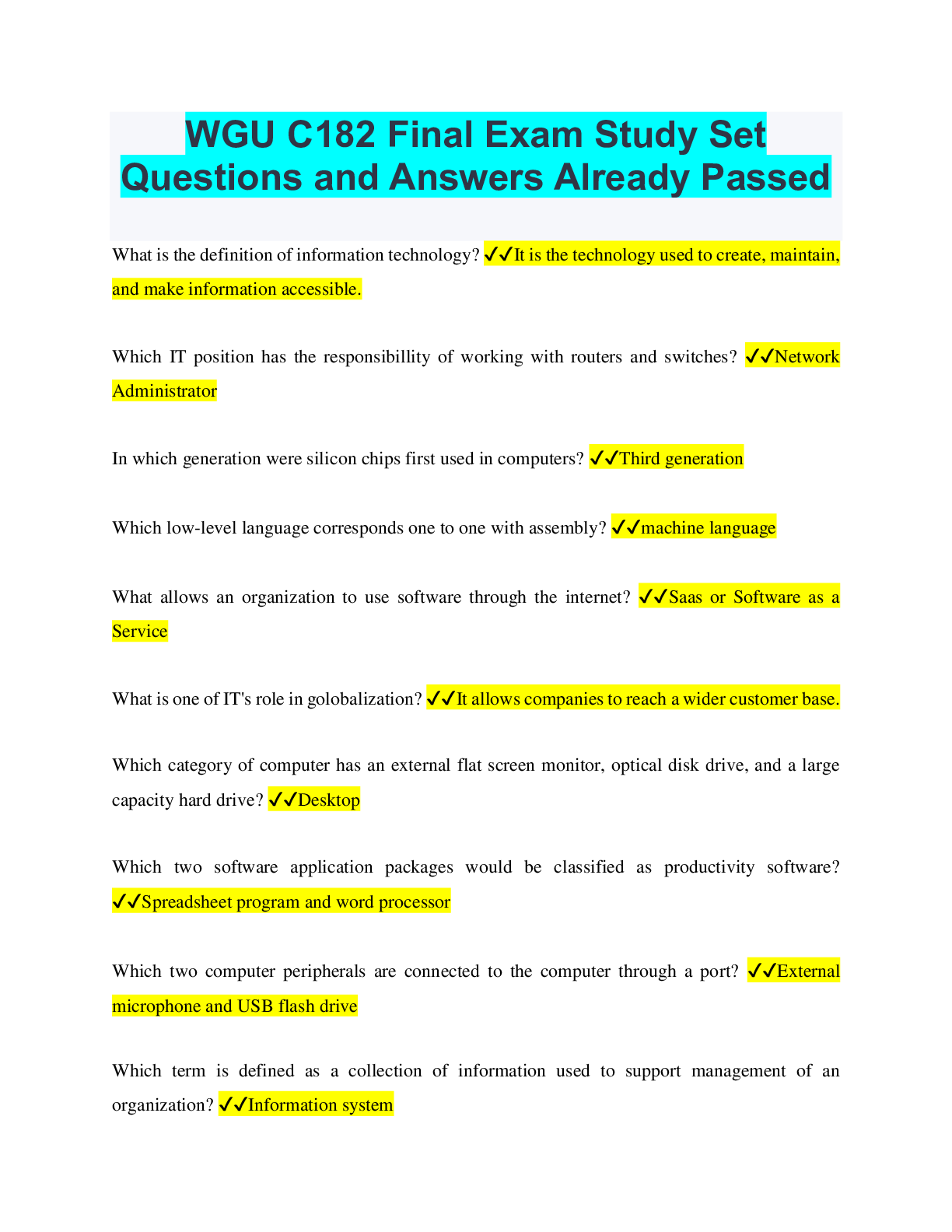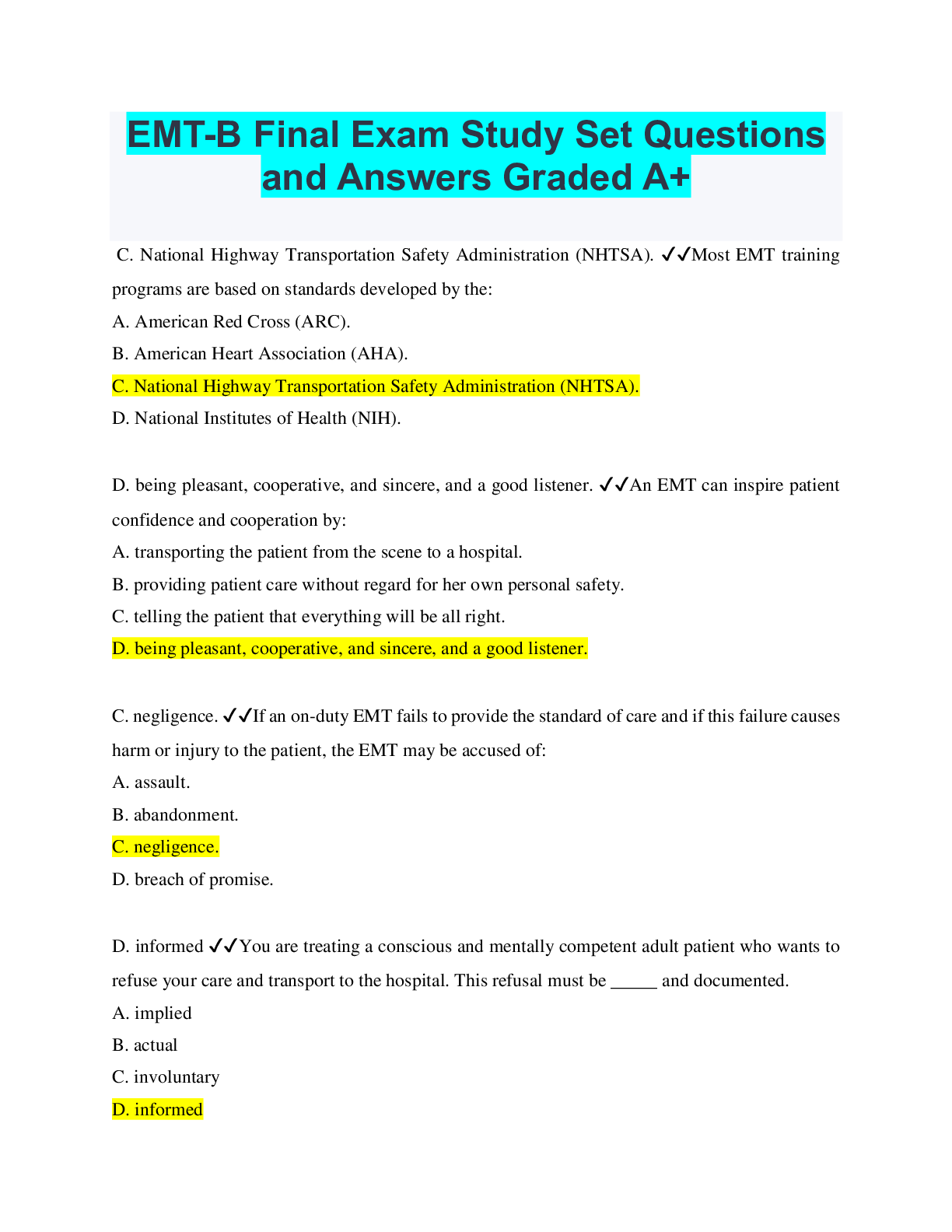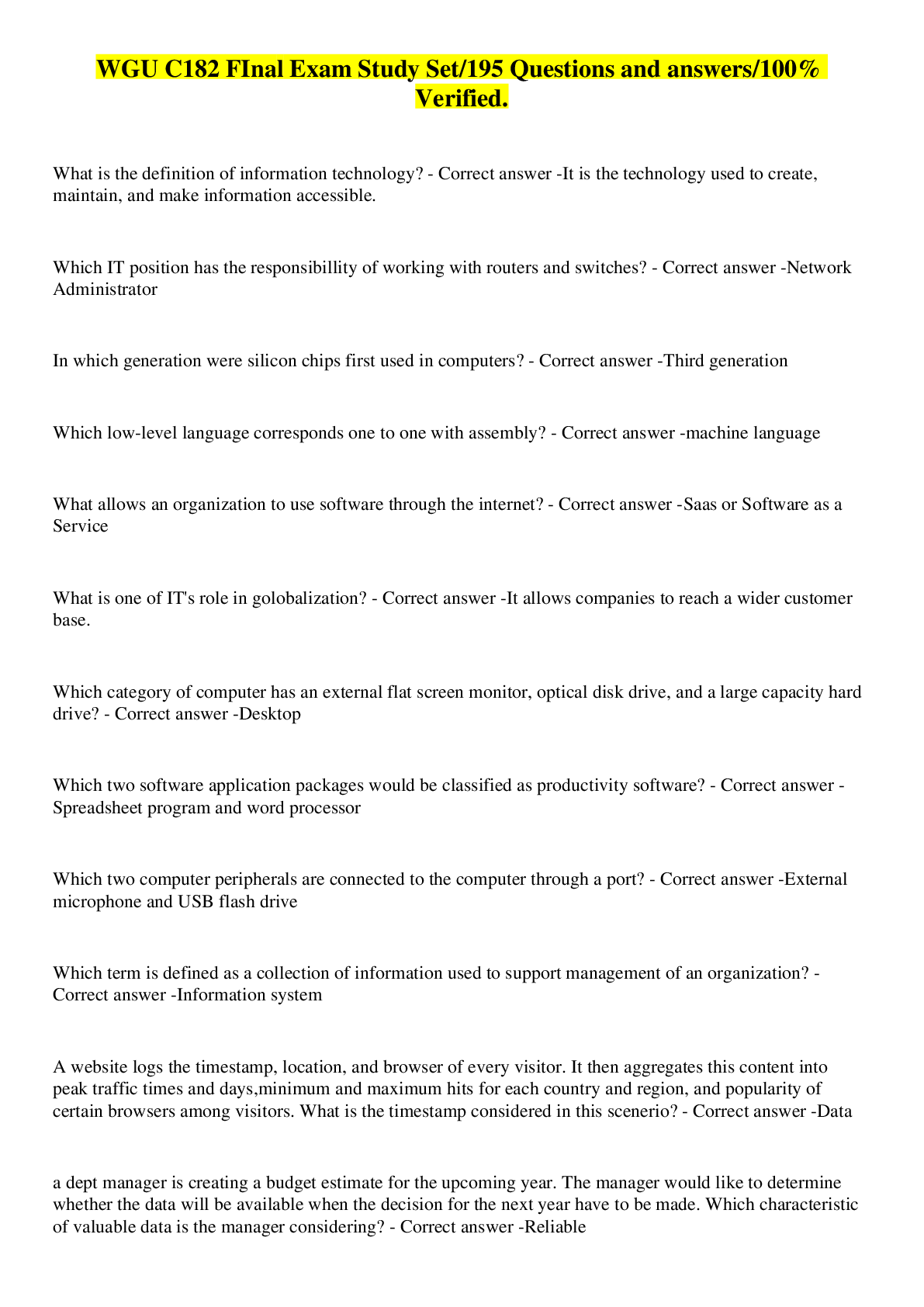Portage Learning Module 7 Problem Set Questions and Answers,100% CORRECT
Document Content and Description Below
Portage Learning Module 7 Problem Set Questions and Answers 1. The urinary system has kidneys, ureters, and bladder. 2, 2, 1 2. Describe the shape, weight and location of the adult kidney. B... ean-shaped, 5 oz, Right lower than the left (Liver above it), Between T12 & L3 vertebra 3. The glands are located on top of each kidney. Adrenal Glands 4. Describe the three layers of protective tissue that surround the kidney. Renal Capsule (inner, tough, fibrous, protect from injury and infection), Adipose Capsule (middle, fatty, cushion), Renal Fascia (outer, dense, fibrous, connective keep kidney in place inside the abdominal cavity) 5. A vertical cross section shows what three regions inside the kidney? Cortex, Medulla, Pelvis 6. The is a continuous outer region with several cortical columns. Renal Cortex 7. The renal medulla is divided into sections called . Pyramids 8. Describe the renal pelvis. Funnel-shaped, connects to ureter as it leaves the Hilus 9. Label blood supply to and within the kidney. Make any notes/comments here. Done 10. Trace the flow of blood through the vessels of the kidney from renal artery into the glomerulus and back to the renal vein. Renal artery from abdominal aorta Segmental artery Lobar Artery Interlobar Artery Arcuate Artery Interlobular Artery Afferent Arteriole Glomerular Capillaries Efferent Arteriole Vasa recta Capillaries Interlobular Vein Arcuate Vein Interlobular Vein Interlobar Vein Renal Vein 11. Input from the adjusts the diameter of the renal arteries thereby regulating renal blood flow. Sympathetic Innervation 12. Urine is carried from the kidneys to the bladder by thin muscular tubes called . Ureters 13. are sphincters located where the ureters enter the bladder. Ureterovesical Valves 14. Describe the three layers of the ureter wall. Transitional Epithelium (inner lining, continuous with kidney’s lining), Muscular Layer (Longitudinal & Circular sheets, propel urine to bladder via contractions), Adventitia Layer (Fibrous connective tissue) 15. Describe the urinary bladder. Compare male and female locations. Bladder is a hollow muscular pouch which receives and stores urine which exits through the urethra. In males, base of bladder is in front of rectum and behind pubic symphysis. In females, bladder is below uterus and in front of vagina, so max capacity is lower in females. 16. Both ureters open into the bladder via the . Ureteral Orifices 17. Describe the three layers of the bladder. Outer Adventitia (fibrous connective tissue), Detrusor Muscle (middle muscular layer, longitude and circular layers), Inner Mucosal Layer (transitional epithelium cells enable cell expansion to absorb fluid) 18. Describe the bladder when it is full and when it is empty. Collapses into pyramid shape when empty, swell and rise in abdomen when full and pear-shaped. 19. Label the parts of the bladder and its location in males and females. Done 20. Describe the two sphincters of the bladder. Internal Sphincter (involuntary, keep urethra closed), External Sphincter (skeletal muscle, voluntary, surrounds urethra as it passes through the pelvic floor) Anatomy of the Urinary System 21. Discuss the differences between the male and female urethra. Male- longer; Female- shorter (UTI vulnerable) 22. What are the three regions of the male urethra? Prostatic urethra (runs within prostate gland), Membranous urethra (runs within urogenital diaphragm), Spongy urethra 23. What is a nephron? Basic structural functional unit in the kidneys. The function of the nephron is to control the concentration of water and soluble materials by filtering the blood, reabsorbing needed materials and excreting the rest as urine. 24. Each nephron consists of: Glomerular Capsule and Renal tube 25. The renal tubule is made of: PCT, Loop of Henle, DCT 26. Label the parts of a nephron. Done 27. Describe the structure of the renal corpuscle. Therenalcorpuscle is composed of the glomerulus, a network of tiny blood capillaries surrounded by the glomerular (Bowman's) capsule, a double-walled simple squamous epithelial cup. The glomerular capillaries are extremely porous. The capillary endothelium has pores which allow certain substances to leave the capillaries. 28. What causes water and solutes to leave the glomerulus? The afferent arteriole, which is fed by the interlobular artery, is much larger in diameter than the efferent arteriole. The difference in diameter causes an extremely high blood pressure in the glomerular capillaries, forcing water and solutes out of the blood, making filtration possible. Water and solutes leave the glomerulus, enter the glomerular capsule, and subsequently flow into the renal tube. 29. Once water and solutes leave the blood and enter the glomerular capsule it is called . Filtrate 30. are found in the cortex region of the kidney, except for a portion of their loop of Henle which extends into the medulla. pass deeply into the medulla because of their location and their longer loops of Henle. Cortical nephrons, Juxtamedullary Nephrons 31. Describe the proximal convoluted tubule PCT- specializedtoreabsorbwaterandmanysolutesfrom the glomerularfiltrateintothelow-pressureperitubularcapilariesthatsuroundtherenaltubuleaswelas secretecertainunwantedsubstances. 32. Describe the loop of Henle. Initialythelo pofHenlehasthedescendinglimbfolowedbytheascending limb.Thedescendinglimbalowswaterlossandtheascendinglimbalowssalt(NaCl)loss. 33. Describe the distal convoluted tubule. DCT - highlycoiled, whichalowsforhormonalycontroled reabsorptionofwaterandsolutesTheDCTismostlyresponsibleforthesecretionofunwanted substances. 34. What are the three types of capillaries associated with nephrons and their function? Glomerular Capillaries (highly coiled capillary beds formed from the afferent arteriole, leaving as the efferent arteriole), Peritubular Capillaries (closely follow the renal tubules and drain into the interlobular vein), Vasa Recta (follow Loop of Henle in Juxtamedullary nephrons of Medulla). 35. Describe the process of micturition. Urine accumulates, the rugae flatten and the wall thins as it stretches allowing bladder to store larger amounts of urine without significant rise in pressure. Urge to urinate starts when 200 ml of urine accumulares, causing distension of the walls which initiates a visceral reflex arc. This causes the detrusor muscle to contract and the internal sphincter to relax forcing stored urine through the internal sphincter into the upper part of the urethra. A person can resist this urge because the external sphincter is voluntarily controlled. As the bladder fills, the desire to urinate becomes strong. If 100% capacity is reached, voluntary sphincter opens and micturition occurs involuntarily. 36. What is incontinence? Inability to control micturition voluntarily 37. What is urinary retention? Inability to expel stored urine; common after general anesthesia (Overgrown prostate in males narrows urethra!) Physiology of the Urinary System 38. How many times a day does the kidney filter through the blood plasma? 60 39. About how many gallons are filtered vs. excreted as urine? 47, .5 40. What are the three steps of urine formation? Filtration, Reabsorption, Secretion 41. What is Blood hydrostatic pressure (HP)? Pressure in blood capillaries, drives fluids out of glomerular capillary 42. What is Colloid osmotic pressure (COP)? Depends on proteins in blood plasma. COP opposes blood hydrostatic pressure by driving fluids back into capillary beds. (aka Oncotic Pressure) 43. What is the normal range of COP? *Memorize this normal range for the exam* 25-32 mmHg 44. What is capsular pressure? Opposes blood HP; Drives fluid back into capillaries 45. Calculate the net filtration pressure for a patient with a blood hydrostatic pressure of 60mmHg, a colloid osmotic pressure of 32mmHg, and a capsular pressure of 18mmHg. 60-(32+18) = 10 mm Hg 46. What prevents blood cells from leaving the glomerular capillaries? Thesizeofthecapilaryfenestrations preventspassageofblo dcelsandmostblo dproteinsfrom leavingacrossthefilter. 47. What is the GFR? Glomerular Filtration Rate – amount of blood filtered by glomerulus over time 48. What causes an increase in the GFR? a decrease? Increased by in arteriole pressure (increase outgoing forces); Decreased by increase in glomerular osmotic pressure most often caused by dehydration. 49. What happens if the GFR is too slow? too fast? Too Slow – too much Filtrate reabsorbed (including wastes that should be excreted); Too Fast – needed substances cannot be reabsorbed 50. What are the three mechanisms that regulate renal flow? Renal Autoregulation, Nervous System Control, RAA System (Hormonal control) 51. Which mechanism (above) is the kidney controlling its own rate of flow? Renal Autoregulation 52. Describe the nervous system control of the renal flow. Afferent arteriole diameter is narrowed by sympathetic nerve fibers; Release of epinephrine by adrenal medulla causes decrease in renal blood flow and decreases GFR. Physiology of the Urinary System 53. What is the hormonal control mechanism for the renal flow? RAA (responds when body’s blood pressure drops too low; helps reabsorption of more NA+ & H2O from the filtration) REVIEW DIAGRAM 54. Angiotensinogen is a pre-enzyme produced by the and freely circulates in the blood. Liver 55. When blood pressure drops, the enzyme is released by the juxtaglomerular (JG) cells of the nephron. Renin 56. In the , angiotensin I is converted to . Lungs, Angiotensin II 57. Once circulating angiotensin II reaches the adrenal cortex, it causes the release of the hormone . Aldosterone 58. What is reabsorption? Fluid and substances moving from filtrate back into blood. 59. True or false: all reabsorption occurs in the renal tubules by diffusion. False (some ions require active transport) 60. Where does the greatest amount of renal tubular reabsorption occur? In cells of the PCT 61. About what percentage of Na+ is reabsorbed in the PCT? The loop of Henle? The DCT? 65%, 25%, 10% (DCT reclaims nearly all when necessary) 62. What is secretion? Involvessubstancesenteringthefiltratefrom thesuroundingfluid,alowingforthe eliminationofundesirablesubstances,suchasurea. 63. What is countercurrent flow? Movementoffluidsinop ositedirectionsthroughadjacentchan els. 64. When an osmotic gradient is isosmotic, what does this mean? Thefluidoutsideandinsidehavethesame osmoticconcentrations, 65. What is the concentration of the filtrate in the PCT vs. the bottom of the loop of Henle? 300 mOsm/L, 1200 mOsm/L 66. True or False: The descending and ascending regions of the loop of Henle have the same reabsorption characteristics. FALSE 67. True or False: The concentration of urea is relatively low in the distal convoluted tubule and the cortex regions of the collecting ducts because the tubules in the cortex are permeable to it. FALSE (concentrations are high in DCT and cortex regions; these cells are impermeable to urea) 68. ADH is secreted by the . Posterior Pituitary Gland 69. True or False: ADH increases water output. FALSE 70. Describe the action of ADH. ADHinhibitsurineoutputbyincreasingthenumberofchan elsinthecelsofthe colectingducts.Increasingthechan elsalowswatertopasseasilyfrom thefiltrateandmoveintothe suroundinginterstitialspace,eventualyreturningtoblo dcirculation.Waterapidlyleavesthefiltratethrough thechan elsinthecolectingductsopenedbyADH.ADHretainsupto9 % ofwaterinfiltrate,andkidneys excreteverysmalvolumeofhighlyconcentratedurine. 71. Describe the mechanisms of aldosterone. AldosteroneincreasesNa+reabsorptionthroughtheexcretionof hydrogenions(H+).Sodium ionsarepumpedoutofthefiltratewhilehydrogenionsarepumpedinsidefor excretion.Becausewaterfolowssalt,Na+reabsorptionalsocauseswatereabsorption.Asecondactionof aldosteroneistoincreasepotassium secretionthroughsodium-potassium pumps.Na+ispumpedoutofthe filtratetobereturnedtotheblo dwhileK+isexcretedinurine. 72. What are diuretics? Substancesthatactonthenephrontoincreaseurinaryoutput. 73. How do the cardiovascular baroreceptors control the nephron? Thecardiovascularbaroreceptorsareintheaorta andcarotidarteriesunderthecontrolofthevagusandglossopharyngealcranialnerves.Ifblo dvolume(and consequentlyblo dpressure)rises,thebaroreceptorsinhibitsympatheticnervoussystem signalstothekidney, dilatingtheafferentarteriolesthatcaryblo dtotheglomerulus.Thiscausesadramaticincreaseinthe filtrationrate,increasingtheoutputofwaterandNa+,whichreducesblo dvolumetoquicklynormalizethe pressure. 74. Describe normal urine. Clear and Pale to deep yellow color (urocrome), pH 4.5-8, Density 1.003-1.035, 95% water, 5% solutes (urea 2%) Physiology of the Urinary System: Acid/Base Balance 75. Water is found in what two main compartments? Intracellular, Extracellular 76. True or False: A solution has a pH of 0, which is alkaline. FALSE (closer to 0 is a more acidic solution) 77. Describe the impact of weak acids on a solution. Weak acid has tightly bound H+; can’t dissociate to become free H+ 78. What is the normal pH of arterial blood? 7.35-7.45 79. What is the principal method through which acids enter the human body? Cellular Metabolism (Chemical reactions in cells to maintain life) 80. What is an anion? Negatively charged ion 81. What are the three major chemical buffer systems in the body? Bicarbonate (Interstitial), Phosphate (Intracellular), Protein (Main Intracellular Buffer; Largest buffering capacity!) 82. The bicarbonate buffer system is composed of and . Weak Carbonic acid (H2CO3), Bicarbonate ion HCO3-) 83. How does the respiratory center control pH? The respiratory center has chemoreceptors in the medulla of the brainstem which monitor the level of CO2 in the blood. Bicarbonate is the form in which CO2 is transported in the blood plasma. 84. What happens to cause hyperventilation? hypoventilation? If blood pH falls (becomes acidic), respiratory center is excited, causing Hyperventilation. If blood pH rises (become more alkaline), respiratory center is depressed causing Hypoventilation 85. Which system has the largest impact on the level of pH in the blood? Renal system (kidney secretion or retention of bicarbonate ion) 86. What happens in severe alkalosis? Blood pH rises above 7.8 and CNS too excited causing extreme nervousness, muscle contraction, convulsion and death due to stop breathing, 87. What happens in severe acidosis? Blood pH below 7.0, CNS is depressed causing coma and imminent death. 88. What are the normal blood serum levels? (for pH, PCO2, HCO3-) 7.35-7.45, 35-45 mm, 22-26 mEq/L 89. For the following blood values given, determine if the patient is in acidosis or alkalosis, whether the cause is respiratory or metabolic and whether the condition is being compensated. pH = 7.7, PCO2 = 23 mm, HCO3- = 24 mEq/L pH: Alkalosis PCO2: Respiratory HCO3- : Normal, not compensating 90. For the following blood values given, determine if the patient is in acidosis or alkalosis, whether the cause is respiratory or metabolic and whether the condition is being compensated. pH = 7.6, PCO2 = 49 mm, HCO3- = 29 mEq/L pH : Alkalosis PCO2: Metabolic HCO3- : Not normal, compensating (Hypoventilation to decr CO2 elimination) 91. Review all figures and tables in module 7. Done [Show More]
Last updated: 1 year ago
Preview 1 out of 11 pages
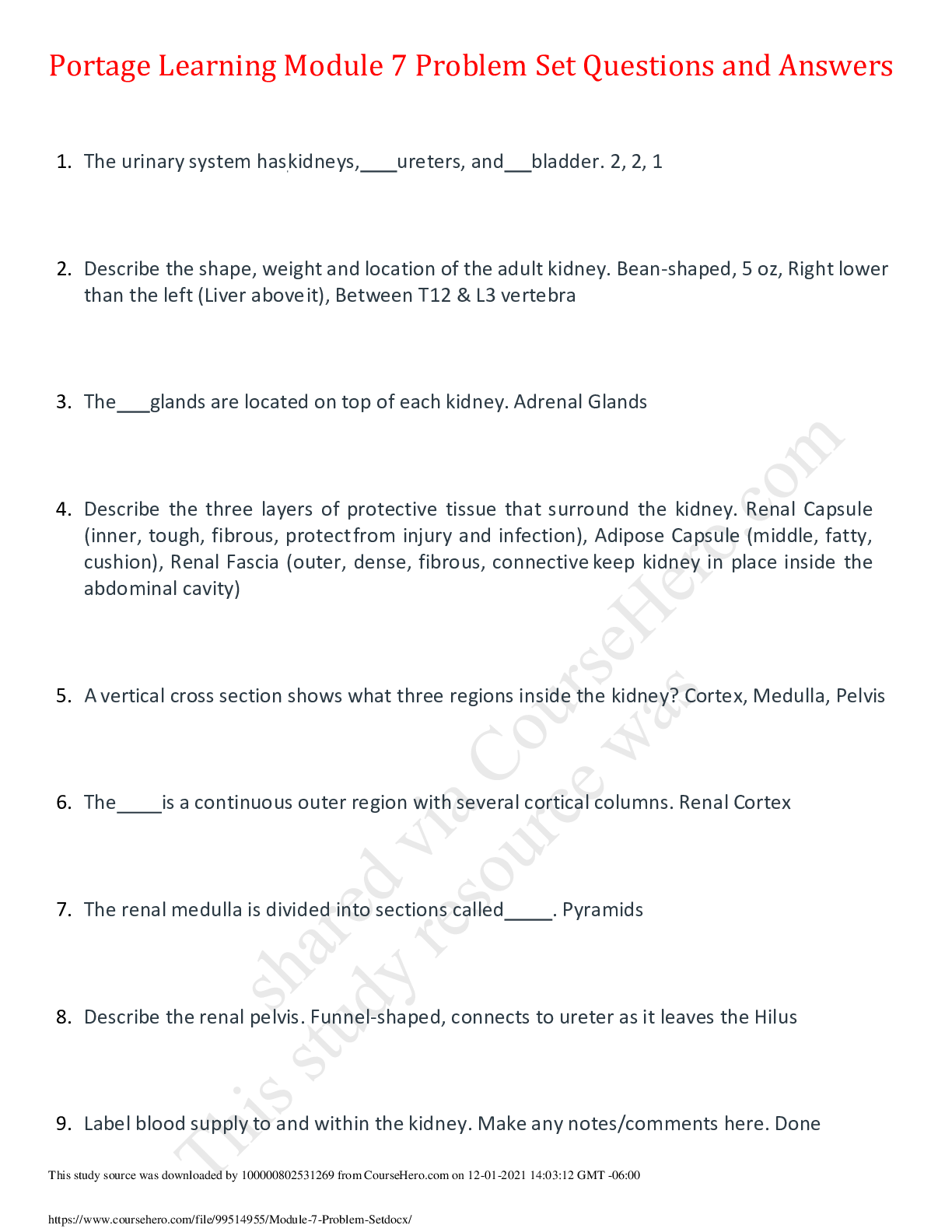
Reviews( 0 )
Document information
Connected school, study & course
About the document
Uploaded On
Dec 07, 2021
Number of pages
11
Written in
Additional information
This document has been written for:
Uploaded
Dec 07, 2021
Downloads
0
Views
65






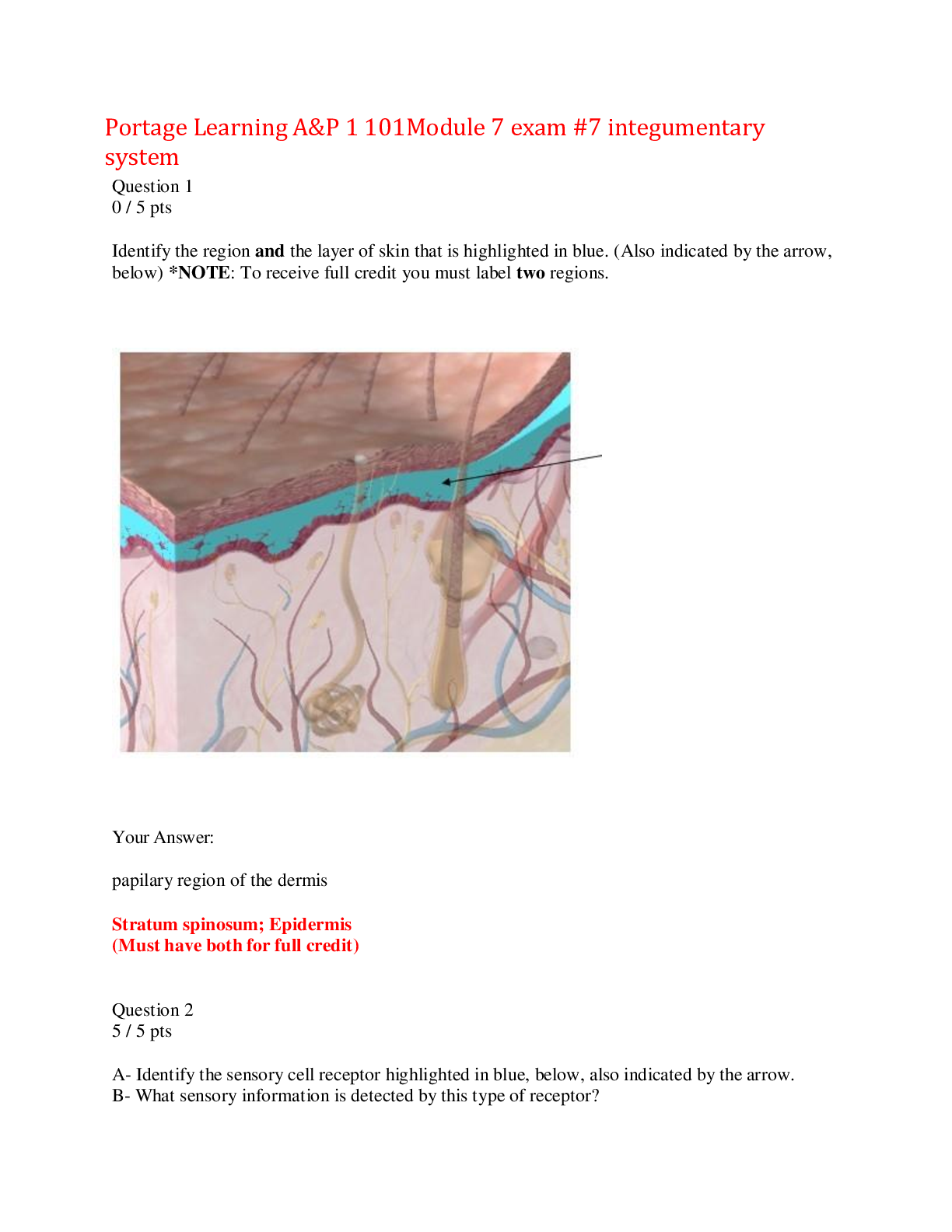







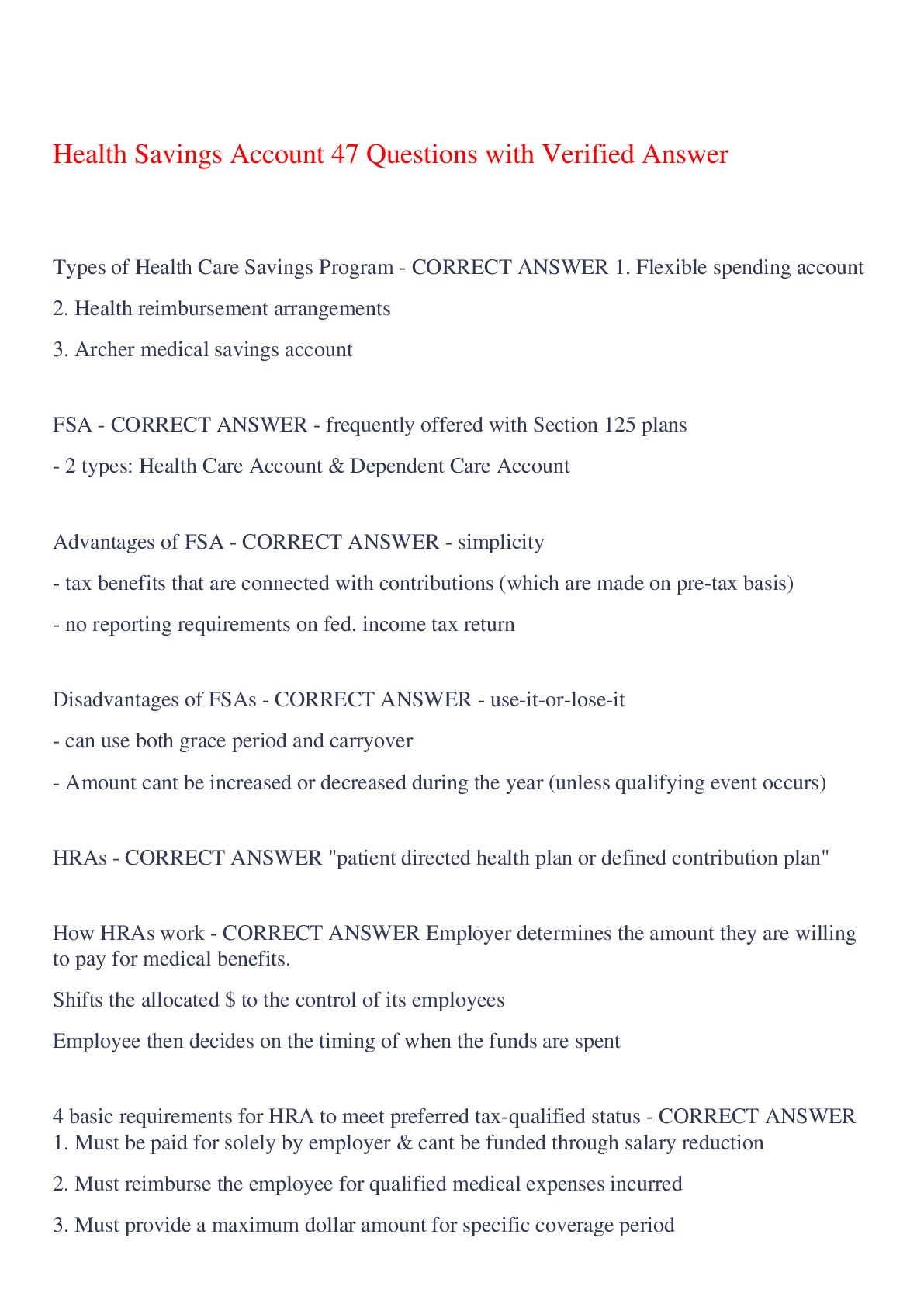


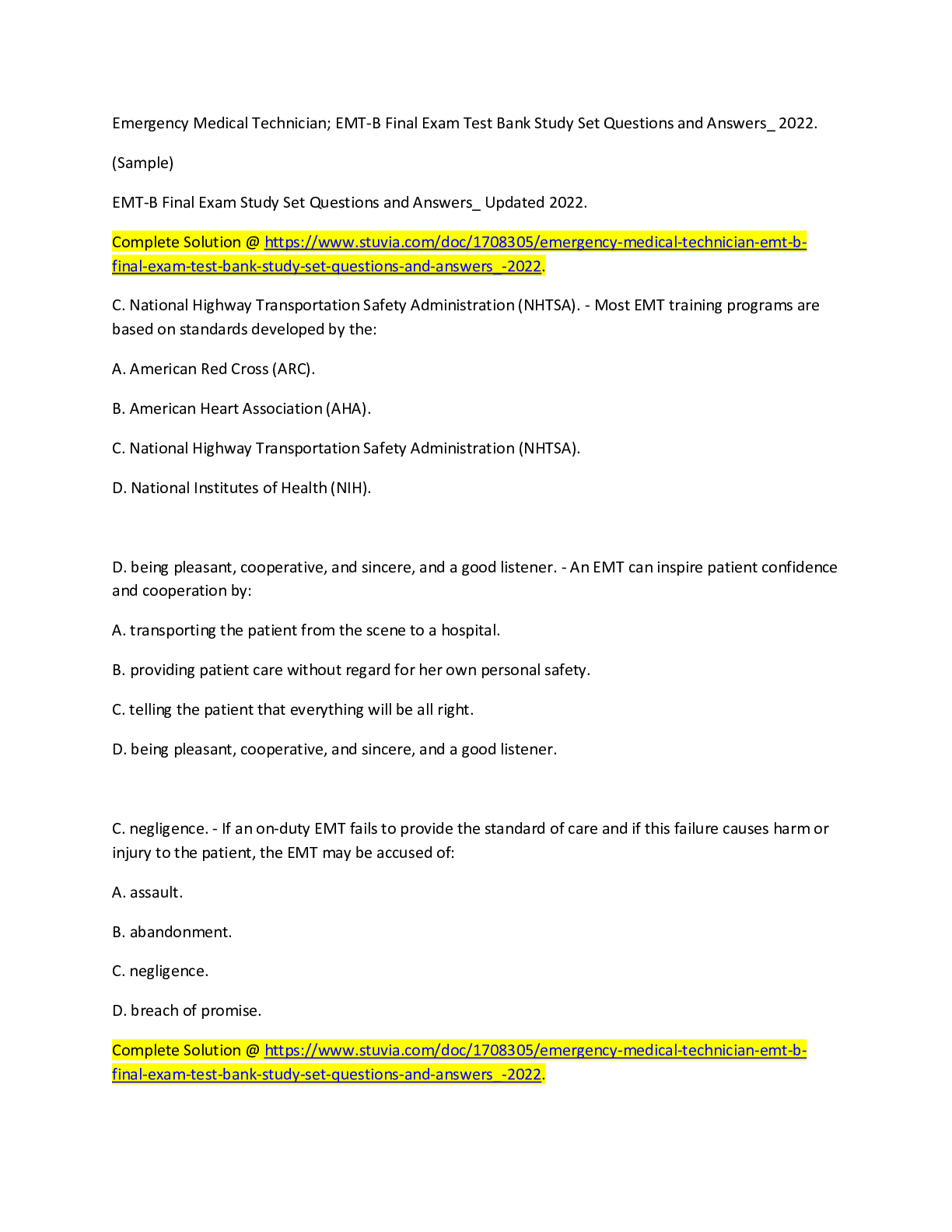
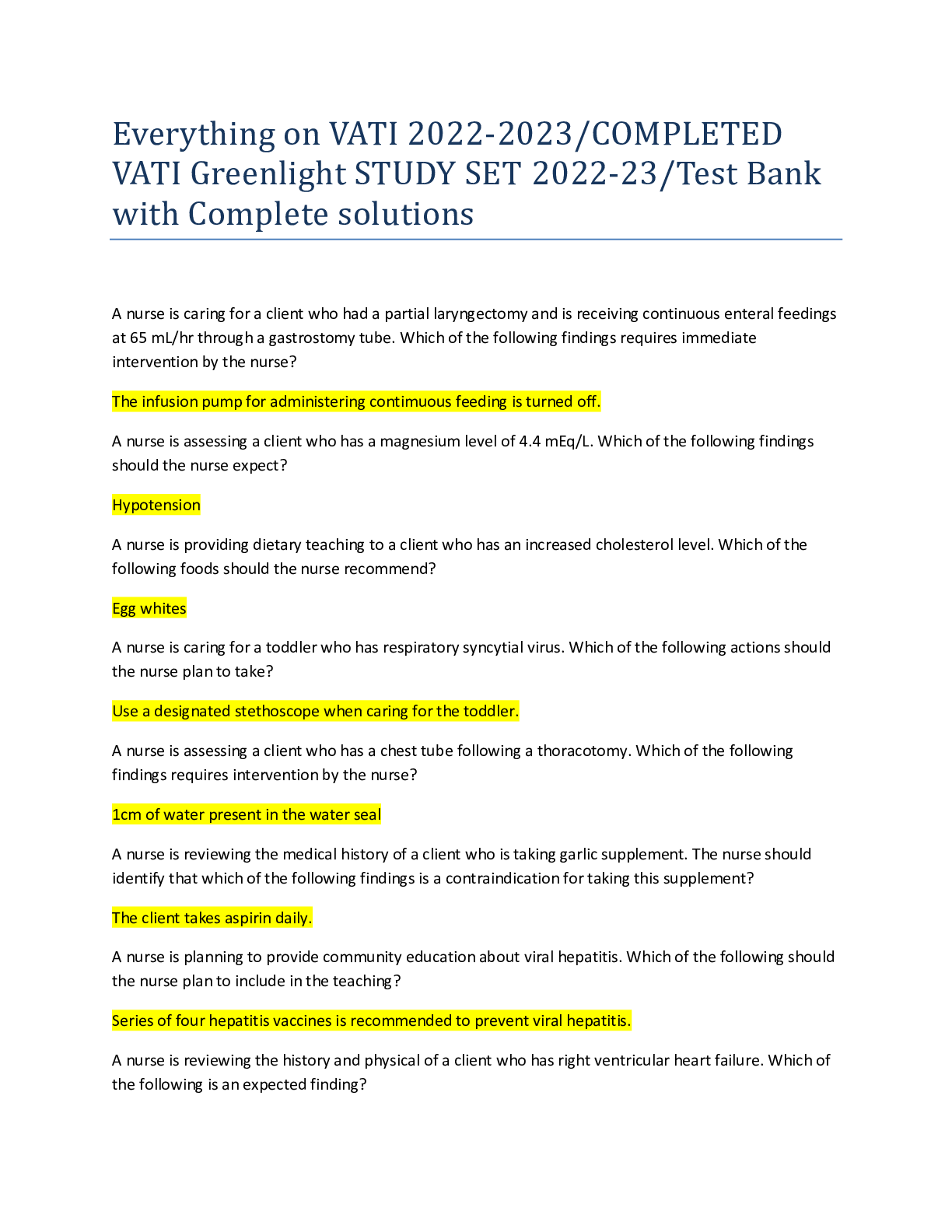

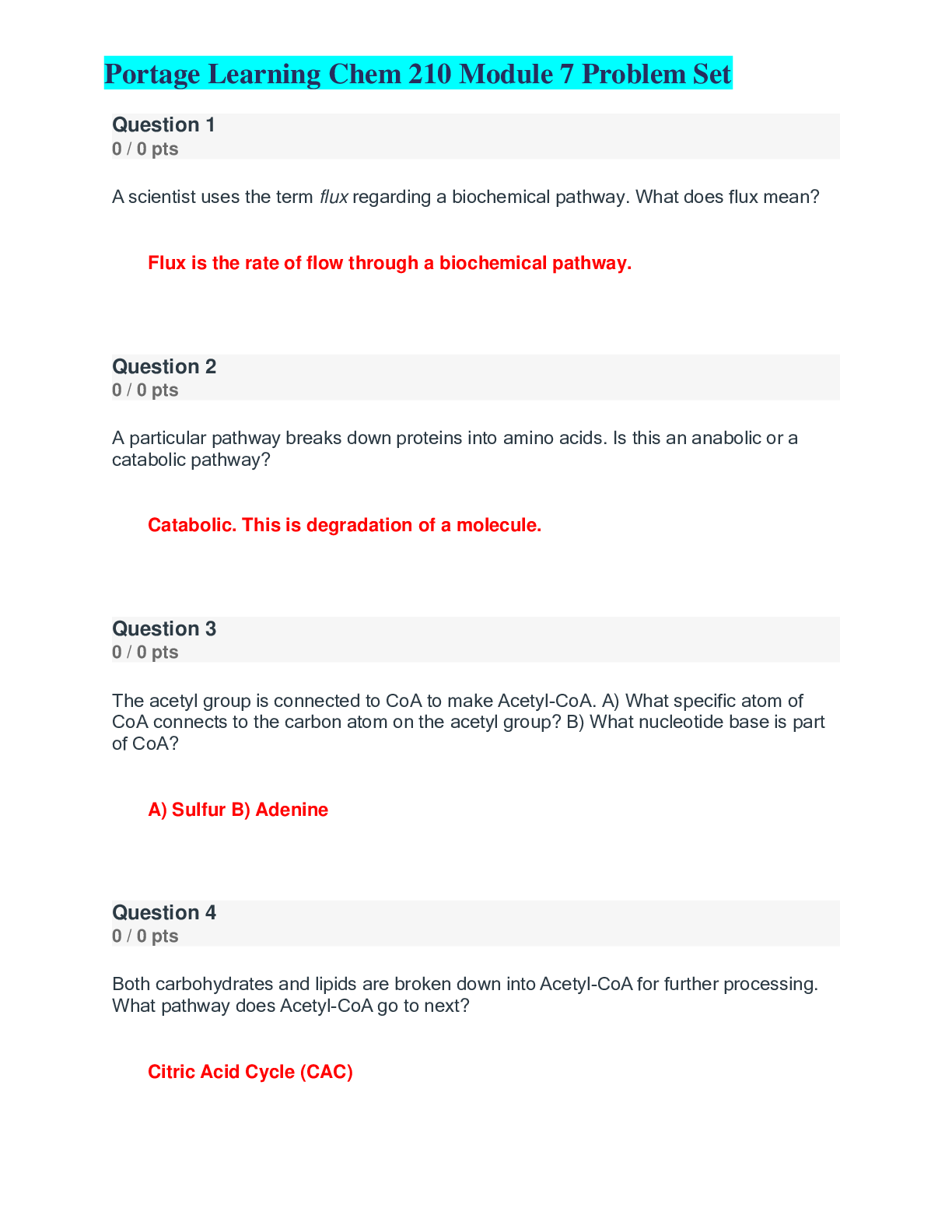
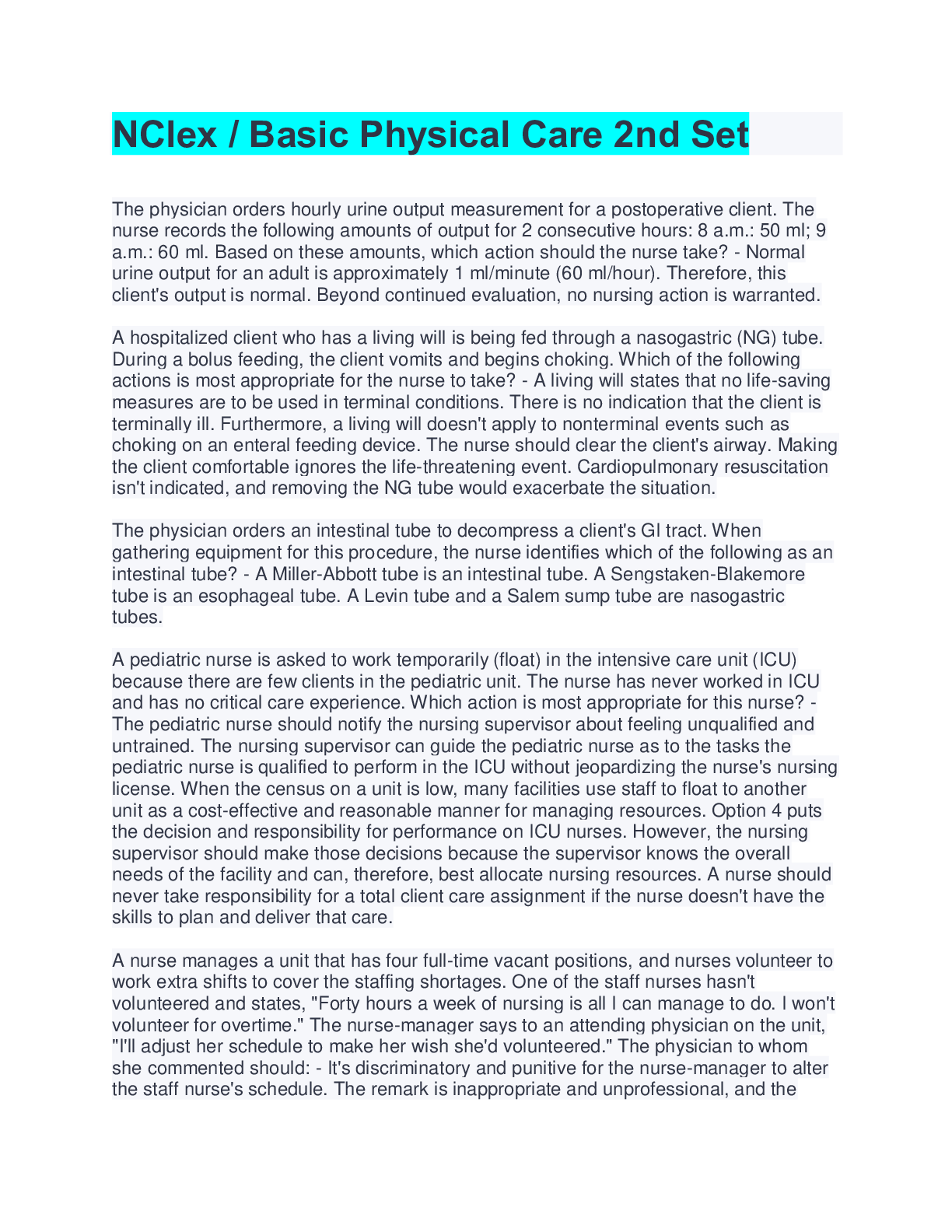
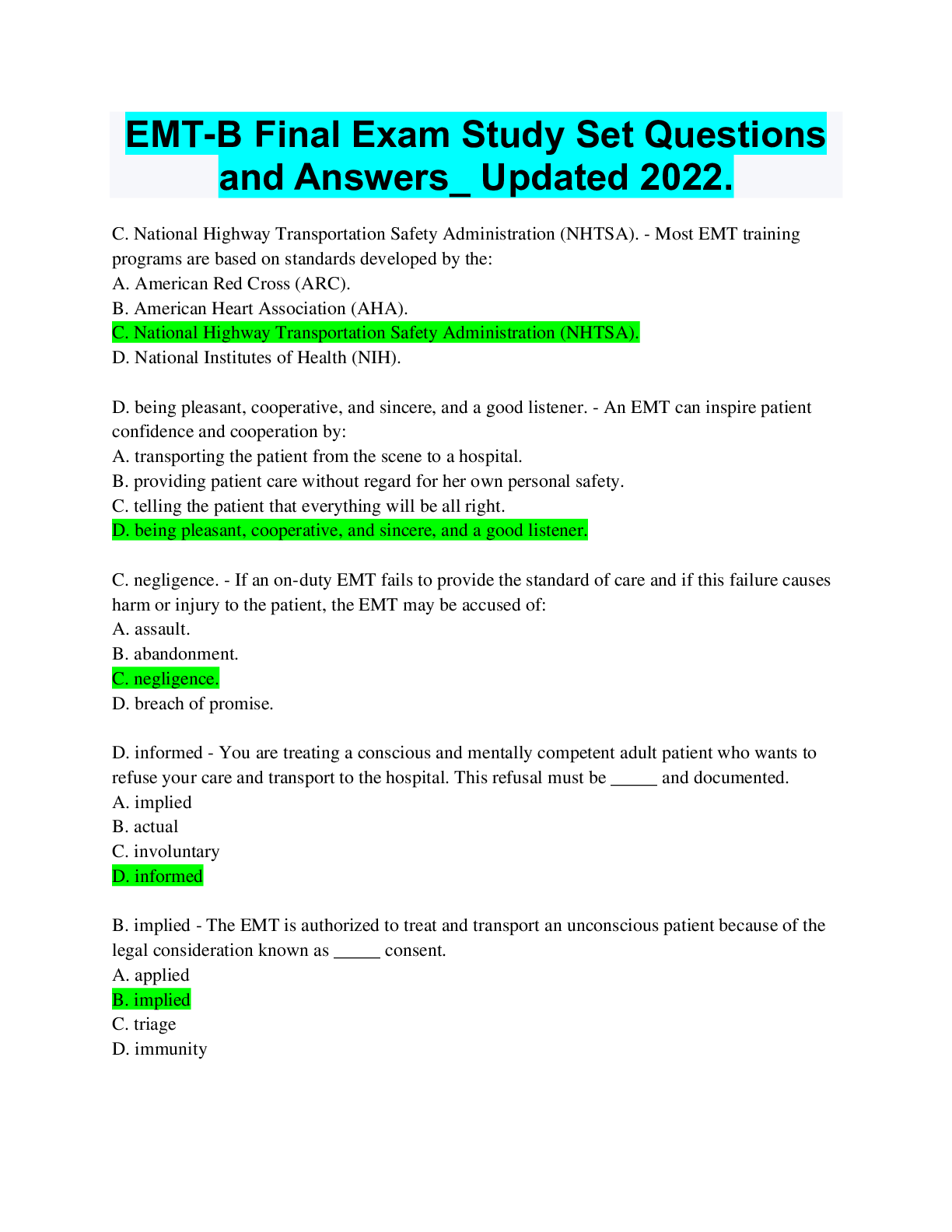



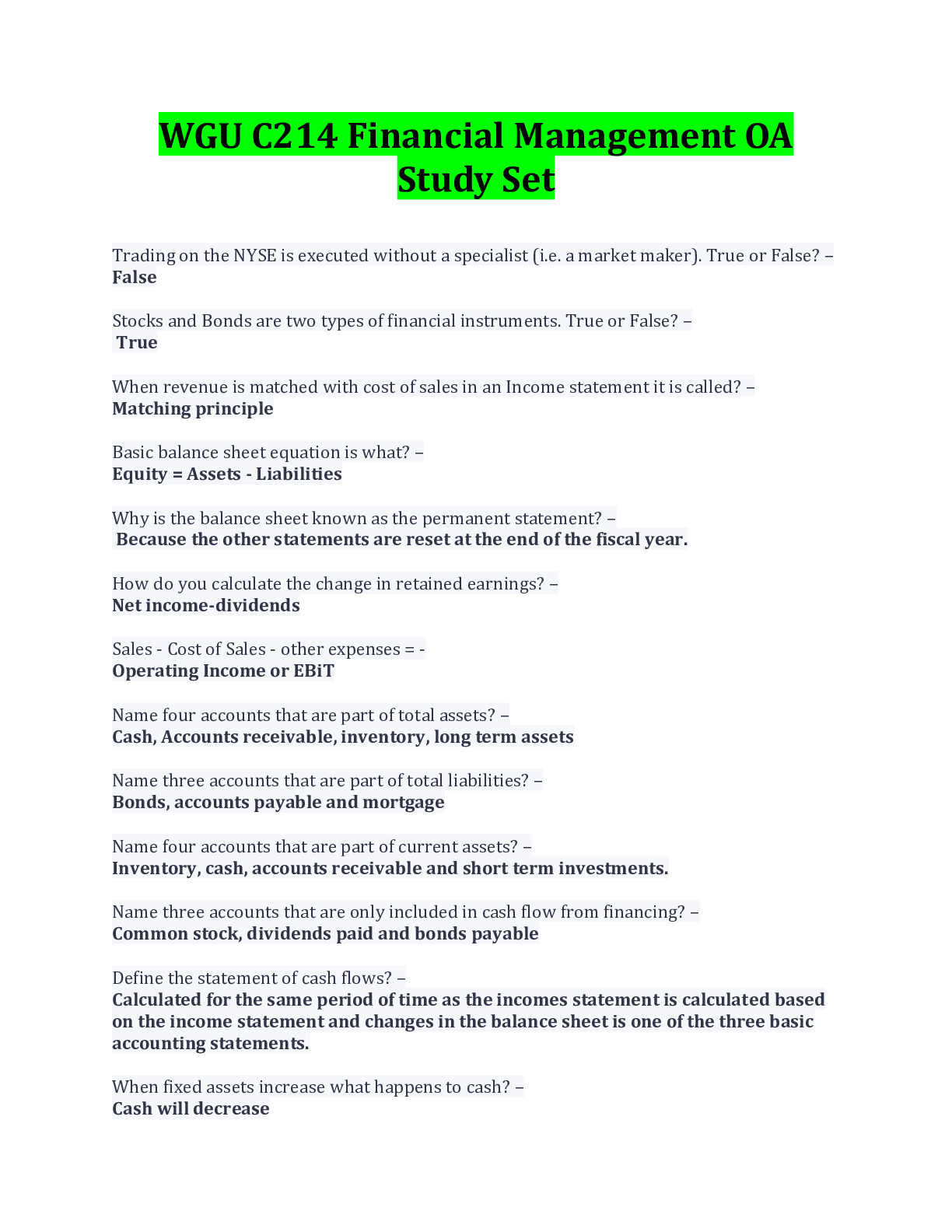

.png)

